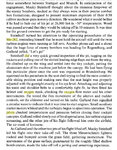MrSmoothie
Airman
- 72
- Jan 21, 2019
From what I've read, production ME-262's had pressurized cockpits. However, I've found at least two ME-262 pilot memoirs which specifically refer to their oxygen masks in one way or another. Is it possible that they wore O2 masks in addition to the cockpit being pressurized as a safeguard against combat damage? Can anybody shed light on this? Here's one account below and I'll attach another:
"The kette attack formation worked well with the 262, since we were not expected to engage in twisting and turning dogfights, but mainly attack bombers. The only problem with the method was if you used the one-two-three attack method. This was so that each aircraft would fire, roll away or pull out, followed the next one, and so on. If the targets were destroyed before the last pilot attacked, all was usually well. If it was not destroyed, then by the time the last one came in, the enemy gunners knew what to expect. This was how I was shot down once. It was a very interesting day.
"We were attacking a large B-17 formation, and this was interesting because we also hit a B-24 group, and I was the fifth aircraft to attack. The first four had scored hits on perhaps three bombers, and two were falling out of formation. Another later exploded. As I came in I saw the tracers hitting the front of my fighter, I could feel the impact, but I heard nothing. I sighted quickly, stayed focused, fired, and saw the left wing catch fire, and men started bailing out.
"Unfortunately the gunners hit my right engine, which just stopped, and the canopy shattered. The tail was shot up as I banked right and pulled up, and then I felt many strikes against the underside, just under my armor plated seat. Then I lost power, the left engine blew up internally, and I was then nothing more than a heavy glider and out of control. I decided to try and roll the fighter upside right, stabilize it, and then roll slightly after dumping the canopy. This would then allow me to pull up, bleed off airspeed, and climb out to jump clear of the tail section.
"I was at about twelve thousand feet when I left the jet; my oxygen mask had been blown off, along with my left boot, as the flash of fire that I had felt was in fact the oxygen bottle exploding, which was what blew me out of the jet in the first place, and not the fuel cells. I managed to correct myself as I fell. I just hoped the thing held together. I came in for my landing and I was hit again, the rest of the jet just fell apart, and I hit the ground rolling, then bumping along when the nose wheel collapsed, then the jet slowed to a stop, but I was not in it. I was already out, wounded again."{3}
"The kette attack formation worked well with the 262, since we were not expected to engage in twisting and turning dogfights, but mainly attack bombers. The only problem with the method was if you used the one-two-three attack method. This was so that each aircraft would fire, roll away or pull out, followed the next one, and so on. If the targets were destroyed before the last pilot attacked, all was usually well. If it was not destroyed, then by the time the last one came in, the enemy gunners knew what to expect. This was how I was shot down once. It was a very interesting day.
"We were attacking a large B-17 formation, and this was interesting because we also hit a B-24 group, and I was the fifth aircraft to attack. The first four had scored hits on perhaps three bombers, and two were falling out of formation. Another later exploded. As I came in I saw the tracers hitting the front of my fighter, I could feel the impact, but I heard nothing. I sighted quickly, stayed focused, fired, and saw the left wing catch fire, and men started bailing out.
"Unfortunately the gunners hit my right engine, which just stopped, and the canopy shattered. The tail was shot up as I banked right and pulled up, and then I felt many strikes against the underside, just under my armor plated seat. Then I lost power, the left engine blew up internally, and I was then nothing more than a heavy glider and out of control. I decided to try and roll the fighter upside right, stabilize it, and then roll slightly after dumping the canopy. This would then allow me to pull up, bleed off airspeed, and climb out to jump clear of the tail section.
"I was at about twelve thousand feet when I left the jet; my oxygen mask had been blown off, along with my left boot, as the flash of fire that I had felt was in fact the oxygen bottle exploding, which was what blew me out of the jet in the first place, and not the fuel cells. I managed to correct myself as I fell. I just hoped the thing held together. I came in for my landing and I was hit again, the rest of the jet just fell apart, and I hit the ground rolling, then bumping along when the nose wheel collapsed, then the jet slowed to a stop, but I was not in it. I was already out, wounded again."{3}

